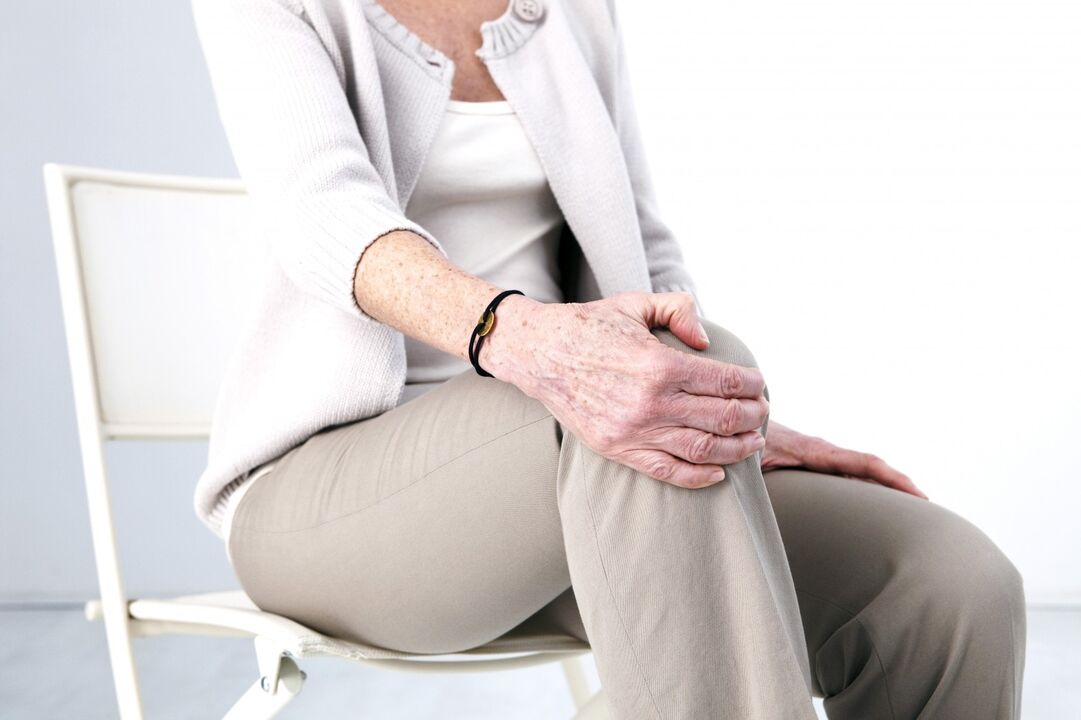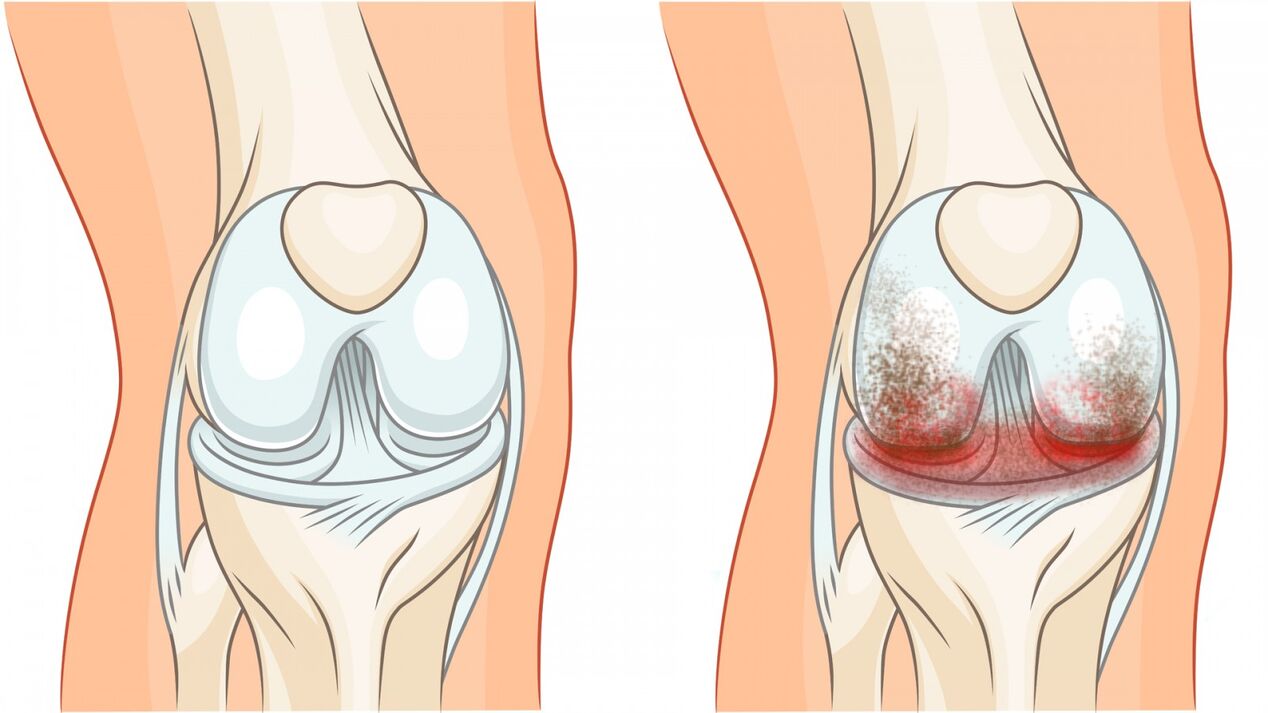Knee pain is a common complaint with which they seek medical attention. What Causes Pain and How To Help Yourself If It Happens? There is no definitive answer, because the knee joints can suffer different types of injuries that arise for many reasons. One of these reasons (and very common) is incipient osteoarthritis. Today we will tell you in detail about osteoarthritis of the knee joint: what are its causes, types, symptoms and signs, we will talk about methods of treatment and prevention.
Types and causes of the disease.
Osteoarthritis of the knee joint or gonarthrosis is a predominantly non-inflammatory lesion that eventually leads to the destruction of the articular cartilage, deformity of the knee and limitation of the range of motion in the knee. The disease has two main forms:
- primary: arises from a congenital joint defect;
- secondary: arises as a result of other illnesses or injuries.
The primary form begins to develop in childhood or youth and is caused by improper formation of the articular surfaces or the ligamentous apparatus. When walking, this joint is exposed to a load disproportionate to its capabilities, causing degenerative changes in it.
The development of a secondary form of pathology can lead to:
- Injuries: fractures of the bones of the legs, contusions and dislocations of the knee, accompanied by damage to the bone and cartilaginous parts of the joint and its ligamentous apparatus. In this case, post-traumatic osteoarthritis of the knee joint develops.
- Operations to remove the meniscus, as they lead to a violation of the integral structure of the knee and its rapid wear.
- The disproportionately high load on the legs that athletes are often subjected to.
- Excessive obesity also causes osteoarthritis, as it leads to excessive pressure of body weight on the articular cartilage of the knee.
- Arthritis is an inflammation of the joints. Prolonged arthritis is accompanied by the formation of fluid in the joint cavity and over time can be complicated by osteoarthritis.
- Metabolic disorders that lead to the deposition of salts in the joint cavities.
- Other factors and diseases accompanied by a prolonged spasm of the leg muscles or blood vessels.
- Operations transferred.
The pathological process can be unilateral or bilateral. Unilateral osteoarthritis (for example, of the right knee) is more likely to develop as a result of trauma, and bilateral osteoarthritis is more likely to develop.

Typical symptoms
Osteoarthritis of the knee joint develops gradually, sometimes it is preceded by months and years of the initial period, when there are still no obvious symptoms (such as severe pain and visible deformity), but from time to time there is a feeling of discomfort in The knees.
Very often, women over 40 who are overweight are sick and, above all, as an aggravating factor, they suffer from varicose veins.
The development of knee osteoarthritis goes through several stages:
- The initial stage can last for months and sometimes years. A person is concerned about periodic pain in the knees, especially when taking the first steps after getting out of bed in the morning, as well as going up and down stairs.
- In the second stage, the pain becomes stronger and already occurs with any movement that is accompanied by a characteristic crunch. Accumulation of fluid is possible in the joint cavity, and upon examination, you may notice an incipient deformation. The range of motion in the sore knee begins to decrease.
- The third stage is characterized by pain that does not go away even at rest. The discomfort usually gets worse before the weather changes. By this time, the joints have largely lost their functions: the legs may hardly bend at the knees, or they may not bend all the way. The way you walk changes: it becomes "waddling" or with your legs bent. The deformation of the knees is very pronounced: the legs are bent and take the shape of O or X.
Symptoms of post-traumatic osteoarthritis of the knee joint develop more quickly. Against the background of the injury, pains in the knee region and its swelling appear. Such pain constantly accompanies a person and increases after physical exertion. Little by little, a feeling of tightness and stiffness in the knee joins him. Sometimes with this form of the disease, it takes only a few months from initial signs to irreversible changes.

Treatment of gonarthrosis
The extent of treatment depends on the stage of the disease and the severity of the injury. But as the disease is chronic, the only thing that can be achieved is long-term remission (resting phases when the manifestations of the pathology are minimal or absent). At the same time, if in the early stages it is possible to eliminate the cause of osteoarthritis of the knee joint (for example, to reduce body weight), then almost complete recovery is possible.
Goals of gonarthrosis treatment:
- eliminate pain,
- if possible, restore the destroyed cartilage and ligamentous apparatus,
- increase the range of motion in the joint.
Treatment methods:
- drug therapy,
- massage and manual therapy,
- Surgical intervention,
- rehabilitation therapy (exercise therapy, physical therapy, and other methods).
Only a doctor can choose the right medicine; in no case do not prescribe them yourself. Its main action is aimed at:
- Elimination of the symptoms of osteoarthritis of the knee joint: relieves pain and inflammation. For this, appropriate drugs are prescribed, including hormones, which are injected into the joint cavity.
- Improves blood supply to the affected area. It is provided by means that relieve vascular spasms and relax the muscles.
- Cartilage restoration. For this, drugs are prescribed that nourish and restore cartilage.
Manual impact and massage reduce pain, relax spasmodic muscles near the affected knee, help increase range of motion, correct bone position, and increase blood circulation.
With far-reaching irreversible injuries, knee osteoarthritis is treated with a radical method - prosthetics, that is, implantation of a metal prosthesis to replace the destroyed joint. So far this is the only way that provides the possibility of a full recovery, however stents have a limited lifespan, after which they must be replaced. Since the cost of such operations is very high, this method of treatment has not yet become widespread.
Rehabilitation therapy includes physical therapy, kinesitherapy (exercises with special loads and simulators), physical therapy, and spa treatment.
Orthopedic methods are aimed at relieving the sore knee - these are canes, braces, etc. , that facilitate the walk (they are used if necessary).
There are many popular recipes for various herbal ointments and compresses, medical bile, and warming bandages made from natural wool are used. Basically, the action of such methods is aimed at relieving pain and eliminating the main symptoms.
Prevention measures
Prevention of knee osteoarthritis includes many factors:
- Balanced nutrition: the diet must have a sufficient amount of proteins, vitamins and minerals.
- Fight wrong lifestyle and get rid of bad habits.
- Weight normalization.
- Adequate physical activity.
- Injury prevention when playing sports, lifting weights.
The most important thing to identify a pathology such as osteoarthritis of the knee is not to initiate the disease, since its far-reaching stages lead to disability. But if all efforts are directed in time to treatment and prevention, until time is wasted and the symptoms are insignificant, there is a possibility of a complete cure of the disease.


























